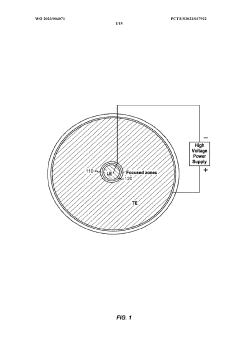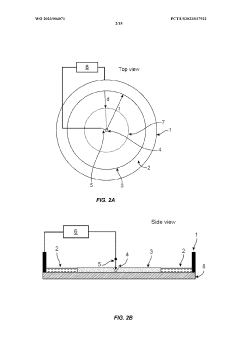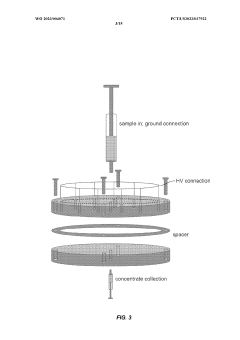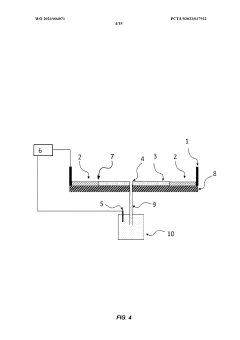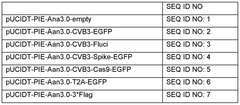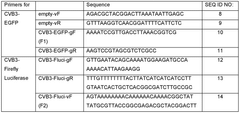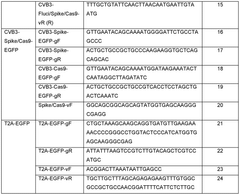Advances in Gel Electrophoresis for RNA Analysis
JUN 30, 20259 MIN READ
Generate Your Research Report Instantly with AI Agent
Patsnap Eureka helps you evaluate technical feasibility & market potential.
RNA Gel Electrophoresis Background and Objectives
Gel electrophoresis has been a cornerstone technique in molecular biology for decades, playing a crucial role in the analysis of nucleic acids, including RNA. The technique's evolution has been closely tied to advancements in RNA research, making it an indispensable tool for studying gene expression, RNA processing, and quality control in various biological and biomedical applications.
The primary objective of RNA gel electrophoresis is to separate RNA molecules based on their size and charge, allowing researchers to visualize and analyze different RNA species. This technique has undergone significant improvements since its inception, driven by the increasing demand for more sensitive, accurate, and high-throughput RNA analysis methods.
Initially, RNA gel electrophoresis was performed using agarose gels, which provided a simple and cost-effective means of separating larger RNA molecules. However, the need for higher resolution in separating smaller RNA species led to the development of polyacrylamide gel electrophoresis (PAGE) for RNA analysis. PAGE offers superior resolution for separating RNA molecules, particularly those in the range of 10-1000 nucleotides.
The advent of denaturing conditions in gel electrophoresis marked a significant milestone in RNA analysis. Denaturing agents such as formaldehyde or urea were introduced to disrupt RNA secondary structures, ensuring that separation is based solely on the molecule's size. This innovation greatly improved the accuracy and reproducibility of RNA size determination.
Another key development was the introduction of capillary gel electrophoresis, which automated the process and allowed for higher throughput and increased sensitivity. This technique has been particularly valuable in applications requiring precise quantification of RNA, such as gene expression studies and quality control of RNA samples.
Recent advances in gel electrophoresis for RNA analysis have focused on improving detection methods, increasing resolution, and adapting the technique for specific RNA types. For instance, the development of highly sensitive fluorescent dyes and imaging systems has enhanced the detection of low-abundance RNA species. Additionally, specialized gel systems have been designed for the analysis of microRNAs and other small non-coding RNAs, which play critical roles in gene regulation.
The ongoing evolution of RNA gel electrophoresis techniques aims to address current challenges in RNA research, such as the need for single-molecule resolution, real-time analysis of RNA dynamics, and integration with other analytical methods. These advancements are crucial for unraveling the complexities of RNA biology and supporting emerging fields like RNA therapeutics and diagnostics.
As we look to the future, the objectives for further development in RNA gel electrophoresis include enhancing sensitivity to detect rare RNA species, improving the ability to analyze complex RNA mixtures, and developing methods for in situ RNA analysis within cellular contexts. These goals align with the broader trends in molecular biology towards single-cell and spatially resolved analyses, which promise to provide unprecedented insights into RNA function and regulation.
The primary objective of RNA gel electrophoresis is to separate RNA molecules based on their size and charge, allowing researchers to visualize and analyze different RNA species. This technique has undergone significant improvements since its inception, driven by the increasing demand for more sensitive, accurate, and high-throughput RNA analysis methods.
Initially, RNA gel electrophoresis was performed using agarose gels, which provided a simple and cost-effective means of separating larger RNA molecules. However, the need for higher resolution in separating smaller RNA species led to the development of polyacrylamide gel electrophoresis (PAGE) for RNA analysis. PAGE offers superior resolution for separating RNA molecules, particularly those in the range of 10-1000 nucleotides.
The advent of denaturing conditions in gel electrophoresis marked a significant milestone in RNA analysis. Denaturing agents such as formaldehyde or urea were introduced to disrupt RNA secondary structures, ensuring that separation is based solely on the molecule's size. This innovation greatly improved the accuracy and reproducibility of RNA size determination.
Another key development was the introduction of capillary gel electrophoresis, which automated the process and allowed for higher throughput and increased sensitivity. This technique has been particularly valuable in applications requiring precise quantification of RNA, such as gene expression studies and quality control of RNA samples.
Recent advances in gel electrophoresis for RNA analysis have focused on improving detection methods, increasing resolution, and adapting the technique for specific RNA types. For instance, the development of highly sensitive fluorescent dyes and imaging systems has enhanced the detection of low-abundance RNA species. Additionally, specialized gel systems have been designed for the analysis of microRNAs and other small non-coding RNAs, which play critical roles in gene regulation.
The ongoing evolution of RNA gel electrophoresis techniques aims to address current challenges in RNA research, such as the need for single-molecule resolution, real-time analysis of RNA dynamics, and integration with other analytical methods. These advancements are crucial for unraveling the complexities of RNA biology and supporting emerging fields like RNA therapeutics and diagnostics.
As we look to the future, the objectives for further development in RNA gel electrophoresis include enhancing sensitivity to detect rare RNA species, improving the ability to analyze complex RNA mixtures, and developing methods for in situ RNA analysis within cellular contexts. These goals align with the broader trends in molecular biology towards single-cell and spatially resolved analyses, which promise to provide unprecedented insights into RNA function and regulation.
Market Demand for RNA Analysis Technologies
The market demand for RNA analysis technologies has been experiencing significant growth, driven by the increasing importance of RNA research in various fields of life sciences. Gel electrophoresis, as a fundamental technique for RNA analysis, continues to play a crucial role in this expanding market.
The global RNA analysis market has been steadily growing, with a particular focus on technologies that offer high-resolution separation and accurate quantification of RNA molecules. This demand is fueled by the rising prevalence of RNA-based therapeutics, the growing field of transcriptomics, and the increasing use of RNA biomarkers in diagnostics and personalized medicine.
In the pharmaceutical and biotechnology sectors, there is a strong need for advanced RNA analysis techniques to support drug discovery and development processes. Gel electrophoresis methods that can provide detailed information on RNA integrity, size distribution, and expression levels are highly sought after. These technologies are essential for quality control in RNA sample preparation, as well as for analyzing the results of RNA-based experiments.
The academic research community also contributes significantly to the market demand for RNA analysis technologies. As researchers delve deeper into understanding gene expression, RNA splicing, and post-transcriptional modifications, there is a growing need for sophisticated gel electrophoresis techniques that can resolve complex RNA populations with high sensitivity and specificity.
Clinical diagnostics represent another major driver of market demand for RNA analysis technologies. The use of RNA biomarkers for disease diagnosis, prognosis, and treatment monitoring has gained traction in recent years. Gel electrophoresis methods that can reliably detect and quantify specific RNA molecules in clinical samples are increasingly valuable in this context.
The COVID-19 pandemic has further accelerated the demand for RNA analysis technologies, particularly in the context of viral RNA detection and vaccine development. This has led to increased investment in RNA analysis platforms, including advanced gel electrophoresis systems, to support rapid and accurate RNA characterization.
As the field of RNA biology continues to expand, there is a growing market for automated and high-throughput gel electrophoresis systems that can handle large numbers of samples with minimal user intervention. This trend reflects the need for increased efficiency and reproducibility in RNA analysis workflows across various research and clinical applications.
The global RNA analysis market has been steadily growing, with a particular focus on technologies that offer high-resolution separation and accurate quantification of RNA molecules. This demand is fueled by the rising prevalence of RNA-based therapeutics, the growing field of transcriptomics, and the increasing use of RNA biomarkers in diagnostics and personalized medicine.
In the pharmaceutical and biotechnology sectors, there is a strong need for advanced RNA analysis techniques to support drug discovery and development processes. Gel electrophoresis methods that can provide detailed information on RNA integrity, size distribution, and expression levels are highly sought after. These technologies are essential for quality control in RNA sample preparation, as well as for analyzing the results of RNA-based experiments.
The academic research community also contributes significantly to the market demand for RNA analysis technologies. As researchers delve deeper into understanding gene expression, RNA splicing, and post-transcriptional modifications, there is a growing need for sophisticated gel electrophoresis techniques that can resolve complex RNA populations with high sensitivity and specificity.
Clinical diagnostics represent another major driver of market demand for RNA analysis technologies. The use of RNA biomarkers for disease diagnosis, prognosis, and treatment monitoring has gained traction in recent years. Gel electrophoresis methods that can reliably detect and quantify specific RNA molecules in clinical samples are increasingly valuable in this context.
The COVID-19 pandemic has further accelerated the demand for RNA analysis technologies, particularly in the context of viral RNA detection and vaccine development. This has led to increased investment in RNA analysis platforms, including advanced gel electrophoresis systems, to support rapid and accurate RNA characterization.
As the field of RNA biology continues to expand, there is a growing market for automated and high-throughput gel electrophoresis systems that can handle large numbers of samples with minimal user intervention. This trend reflects the need for increased efficiency and reproducibility in RNA analysis workflows across various research and clinical applications.
Current Challenges in RNA Gel Electrophoresis
RNA gel electrophoresis remains a crucial technique for analyzing RNA molecules, yet it faces several significant challenges that hinder its effectiveness and reliability. One of the primary issues is the inherent instability of RNA molecules, which are prone to degradation by ubiquitous RNases. This susceptibility to degradation necessitates stringent precautions throughout the entire experimental process, from sample preparation to gel running, making the technique labor-intensive and time-consuming.
Another major challenge is the difficulty in achieving high resolution for RNA molecules of varying sizes. Traditional agarose gels, while suitable for larger RNA fragments, struggle to provide adequate separation for smaller RNA species such as microRNAs or siRNAs. Conversely, polyacrylamide gels offer better resolution for smaller RNAs but are less effective for larger transcripts, creating a trade-off between size range and resolution.
The formation of secondary structures in RNA molecules presents an additional hurdle. These structures can cause anomalous migration patterns, leading to inaccurate size estimations and potentially masking the presence of specific RNA species. Denaturing agents are often employed to mitigate this issue, but their use can complicate downstream applications and analysis.
Quantification accuracy is another area of concern in RNA gel electrophoresis. The non-linear relationship between RNA concentration and band intensity, especially at higher concentrations, can lead to unreliable quantification results. This limitation is particularly problematic when precise quantification is required for subsequent experiments or comparative analyses.
The detection sensitivity of RNA in gel electrophoresis is also a persistent challenge. Traditional staining methods, such as ethidium bromide, may not provide sufficient sensitivity for low-abundance RNA species. While more sensitive fluorescent dyes are available, they often come with increased costs and potential safety concerns.
Reproducibility across different laboratories and even within the same lab remains a significant issue. Variations in gel composition, running conditions, and staining procedures can lead to inconsistent results, making it difficult to compare data across different experiments or research groups.
Lastly, the time-consuming nature of gel electrophoresis poses a challenge in high-throughput RNA analysis scenarios. The lengthy process of gel preparation, running, and imaging can be a bottleneck in large-scale studies or time-sensitive experiments, limiting the technique's applicability in certain research contexts.
Another major challenge is the difficulty in achieving high resolution for RNA molecules of varying sizes. Traditional agarose gels, while suitable for larger RNA fragments, struggle to provide adequate separation for smaller RNA species such as microRNAs or siRNAs. Conversely, polyacrylamide gels offer better resolution for smaller RNAs but are less effective for larger transcripts, creating a trade-off between size range and resolution.
The formation of secondary structures in RNA molecules presents an additional hurdle. These structures can cause anomalous migration patterns, leading to inaccurate size estimations and potentially masking the presence of specific RNA species. Denaturing agents are often employed to mitigate this issue, but their use can complicate downstream applications and analysis.
Quantification accuracy is another area of concern in RNA gel electrophoresis. The non-linear relationship between RNA concentration and band intensity, especially at higher concentrations, can lead to unreliable quantification results. This limitation is particularly problematic when precise quantification is required for subsequent experiments or comparative analyses.
The detection sensitivity of RNA in gel electrophoresis is also a persistent challenge. Traditional staining methods, such as ethidium bromide, may not provide sufficient sensitivity for low-abundance RNA species. While more sensitive fluorescent dyes are available, they often come with increased costs and potential safety concerns.
Reproducibility across different laboratories and even within the same lab remains a significant issue. Variations in gel composition, running conditions, and staining procedures can lead to inconsistent results, making it difficult to compare data across different experiments or research groups.
Lastly, the time-consuming nature of gel electrophoresis poses a challenge in high-throughput RNA analysis scenarios. The lengthy process of gel preparation, running, and imaging can be a bottleneck in large-scale studies or time-sensitive experiments, limiting the technique's applicability in certain research contexts.
Current RNA Gel Electrophoresis Methods
01 Gel electrophoresis techniques for RNA analysis
Various gel electrophoresis techniques are employed for RNA analysis, including agarose and polyacrylamide gel electrophoresis. These methods allow for the separation and visualization of RNA molecules based on their size and charge, enabling researchers to assess RNA integrity, quantity, and quality.- Gel composition for RNA analysis: Specialized gel compositions are developed for RNA electrophoresis, optimizing separation and resolution of RNA molecules. These gels may include specific polymers, buffers, and additives that enhance RNA stability and prevent degradation during the electrophoresis process.
- RNA sample preparation techniques: Various methods are employed to prepare RNA samples for gel electrophoresis, including RNA extraction, purification, and denaturation protocols. These techniques aim to maintain RNA integrity and ensure optimal separation during electrophoresis.
- Electrophoresis apparatus design: Specialized electrophoresis equipment is designed for RNA analysis, featuring modifications to enhance resolution and prevent RNA degradation. This may include temperature control systems, specialized buffer chambers, and electrode configurations optimized for RNA separation.
- RNA visualization and detection methods: Various techniques are developed to visualize and detect RNA bands after gel electrophoresis. These may include fluorescent dyes, staining protocols, and imaging systems specifically designed for RNA analysis, allowing for sensitive and accurate detection of RNA molecules.
- Data analysis and interpretation: Advanced software and algorithms are developed for analyzing gel electrophoresis results of RNA samples. These tools assist in band quantification, size determination, and comparative analysis of RNA profiles, enhancing the interpretation of experimental data.
02 RNA sample preparation and loading
Proper RNA sample preparation and loading techniques are crucial for accurate gel electrophoresis analysis. This includes RNA extraction, purification, and the use of specialized buffers and loading dyes to ensure optimal separation and visualization of RNA molecules on the gel.Expand Specific Solutions03 Staining and visualization methods for RNA
Various staining and visualization methods are used to detect RNA bands after gel electrophoresis. These include fluorescent dyes, ethidium bromide, and silver staining techniques, which allow for the visualization and quantification of RNA molecules separated on the gel.Expand Specific Solutions04 Specialized gel electrophoresis systems for RNA
Specialized gel electrophoresis systems have been developed specifically for RNA analysis, including microfluidic devices and automated systems. These systems offer improved resolution, faster analysis times, and enhanced reproducibility compared to traditional gel electrophoresis methods.Expand Specific Solutions05 Data analysis and interpretation of RNA gel electrophoresis results
Advanced data analysis and interpretation techniques are employed to extract meaningful information from RNA gel electrophoresis results. This includes the use of software for band quantification, quality assessment, and comparative analysis of RNA samples across different experimental conditions.Expand Specific Solutions
Key Players in RNA Analysis Industry
The field of gel electrophoresis for RNA analysis is in a mature stage of development, with a well-established market and proven technologies. The global market size for this technology is substantial, driven by increasing demand in genomics research and molecular diagnostics. Key players like Life Technologies Corp., Beckman Coulter, Inc., and Agilent Technologies, Inc. dominate the landscape, offering advanced solutions. These companies, along with others such as Bio-Rad Laboratories, Inc. and Roche Diagnostics GmbH, continue to innovate, focusing on improving resolution, sensitivity, and automation. The technology's maturity is evident in its widespread adoption across academic, pharmaceutical, and clinical settings, with ongoing refinements aimed at enhancing efficiency and accuracy in RNA analysis.
Life Technologies Corp.
Technical Solution: Life Technologies (now part of Thermo Fisher Scientific) has developed several advanced platforms for RNA analysis using gel electrophoresis techniques. The company's E-Gel system offers pre-cast agarose gels with an integrated buffer chamber, allowing for rapid and convenient RNA separation[9]. The E-Gel Power Snap Electrophoresis System provides automated electrophoresis with real-time LED visualization, enabling monitoring of RNA migration during the run[10]. Life Technologies has also introduced the Attune NxT Flow Cytometer, which, while not a traditional gel electrophoresis system, utilizes acoustic-assisted hydrodynamic focusing for high-resolution analysis of RNA-containing particles or cells[11]. Additionally, the company offers a range of RNA staining dyes and markers compatible with various electrophoresis platforms, enhancing the detection and quantification of RNA samples[12].
Strengths: User-friendly systems, integration of electrophoresis with downstream analysis, and a wide range of compatible reagents. Weaknesses: Some systems may be less flexible for customization compared to traditional gel electrophoresis setups.
Beckman Coulter, Inc.
Technical Solution: Beckman Coulter has made significant advancements in gel electrophoresis for RNA analysis, particularly with their capillary electrophoresis systems. The GenomeLab GeXP Genetic Analysis System utilizes capillary electrophoresis for high-resolution separation of RNA samples, allowing for both qualitative and quantitative analysis[13]. This system can perform multiplexed gene expression analysis, enabling the simultaneous detection of multiple RNA targets in a single reaction[14]. Beckman Coulter's PA 800 Plus Pharmaceutical Analysis System, while primarily designed for protein analysis, has been adapted for RNA applications, offering high-sensitivity capillary electrophoresis with various detection methods, including UV and laser-induced fluorescence[15]. The company also provides a range of reagents and kits optimized for RNA analysis, including fluorescent dyes and RNA ladders for accurate size determination[16].
Strengths: High-resolution separation, multiplexing capabilities, and versatility in detection methods. Weaknesses: Specialized training may be required for optimal use of advanced capillary electrophoresis systems.
Innovations in RNA Separation and Detection
Methods and devices for isolating RNA using epitachophoresis
PatentWO2023004071A1
Innovation
- The epitachophoresis method and device utilize a circular channel with concentric electrolytes and a gel to separate smaller RNA molecules by applying a voltage difference, allowing them to pass through while larger RNA molecules are slowed or trapped, resulting in a higher concentration of small RNA in the collected mixture.
Gel analysis of RNA
PatentWO2024251993A1
Innovation
- The use of denaturing urea-agarose gels with concentrations of urea between 1M to 8M and agarose concentrations of 0.5% to 6% allows for effective separation of circular RNA from linear RNA, regardless of RNA length, using a vertical electrophoresis system that enhances resolution and reduces running times.
Regulatory Considerations for RNA Analysis
Regulatory considerations play a crucial role in the development and implementation of RNA analysis techniques, including gel electrophoresis. As these methods are often used in clinical diagnostics and research with potential impact on human health, they are subject to stringent oversight by regulatory bodies such as the FDA in the United States and the EMA in Europe.
One of the primary regulatory concerns for RNA analysis techniques is the validation and standardization of methods. Regulatory agencies require that gel electrophoresis protocols for RNA analysis demonstrate reproducibility, accuracy, and precision. This involves establishing standard operating procedures (SOPs) and quality control measures to ensure consistent results across different laboratories and operators.
The choice of reagents and materials used in gel electrophoresis for RNA analysis is also subject to regulatory scrutiny. Manufacturers of electrophoresis equipment and reagents must comply with good manufacturing practices (GMP) and provide documentation on the purity, stability, and performance of their products. This is particularly important for RNA analysis, as the integrity and quality of RNA samples can significantly impact experimental outcomes.
Safety considerations are another key aspect of regulatory compliance in RNA analysis. Gel electrophoresis often involves the use of potentially hazardous materials, such as ethidium bromide for nucleic acid staining. Regulatory guidelines mandate proper handling, storage, and disposal procedures for these substances to protect both laboratory personnel and the environment.
For clinical applications of RNA analysis using gel electrophoresis, such as in molecular diagnostics, additional regulatory requirements come into play. These may include obtaining premarket approval (PMA) or 510(k) clearance from the FDA for diagnostic tests based on RNA analysis. Such approvals typically require extensive clinical validation studies to demonstrate the safety and efficacy of the diagnostic method.
Data integrity and traceability are also critical regulatory considerations in RNA analysis. Laboratories must implement robust data management systems that ensure the accuracy, completeness, and security of experimental data. This includes maintaining detailed records of sample preparation, electrophoresis conditions, and analysis parameters.
As the field of RNA analysis continues to advance, regulatory frameworks are evolving to keep pace with new technologies. For instance, the emergence of microfluidic and capillary electrophoresis systems for RNA analysis has prompted regulatory bodies to develop new guidelines for the validation and implementation of these methods. This ongoing dialogue between researchers, industry, and regulators is essential to ensure that innovative RNA analysis techniques can be safely and effectively translated into clinical and research applications.
One of the primary regulatory concerns for RNA analysis techniques is the validation and standardization of methods. Regulatory agencies require that gel electrophoresis protocols for RNA analysis demonstrate reproducibility, accuracy, and precision. This involves establishing standard operating procedures (SOPs) and quality control measures to ensure consistent results across different laboratories and operators.
The choice of reagents and materials used in gel electrophoresis for RNA analysis is also subject to regulatory scrutiny. Manufacturers of electrophoresis equipment and reagents must comply with good manufacturing practices (GMP) and provide documentation on the purity, stability, and performance of their products. This is particularly important for RNA analysis, as the integrity and quality of RNA samples can significantly impact experimental outcomes.
Safety considerations are another key aspect of regulatory compliance in RNA analysis. Gel electrophoresis often involves the use of potentially hazardous materials, such as ethidium bromide for nucleic acid staining. Regulatory guidelines mandate proper handling, storage, and disposal procedures for these substances to protect both laboratory personnel and the environment.
For clinical applications of RNA analysis using gel electrophoresis, such as in molecular diagnostics, additional regulatory requirements come into play. These may include obtaining premarket approval (PMA) or 510(k) clearance from the FDA for diagnostic tests based on RNA analysis. Such approvals typically require extensive clinical validation studies to demonstrate the safety and efficacy of the diagnostic method.
Data integrity and traceability are also critical regulatory considerations in RNA analysis. Laboratories must implement robust data management systems that ensure the accuracy, completeness, and security of experimental data. This includes maintaining detailed records of sample preparation, electrophoresis conditions, and analysis parameters.
As the field of RNA analysis continues to advance, regulatory frameworks are evolving to keep pace with new technologies. For instance, the emergence of microfluidic and capillary electrophoresis systems for RNA analysis has prompted regulatory bodies to develop new guidelines for the validation and implementation of these methods. This ongoing dialogue between researchers, industry, and regulators is essential to ensure that innovative RNA analysis techniques can be safely and effectively translated into clinical and research applications.
Bioinformatics Integration in RNA Electrophoresis
The integration of bioinformatics in RNA electrophoresis has revolutionized the field of RNA analysis, offering unprecedented insights into gene expression and regulation. This convergence of wet-lab techniques and computational methods has significantly enhanced the accuracy, efficiency, and scope of RNA studies.
Bioinformatics tools have been developed to streamline the analysis of gel electrophoresis data, enabling researchers to extract more information from their experiments. These tools can automatically detect and quantify RNA bands, normalize data across multiple samples, and perform statistical analyses to identify significant differences in RNA expression levels.
Machine learning algorithms have been applied to improve the interpretation of electrophoresis results. These algorithms can recognize complex patterns in gel images, distinguish between closely migrating RNA species, and even predict the presence of specific RNA modifications based on migration patterns.
The integration of bioinformatics has also facilitated the comparison of gel electrophoresis data with other types of RNA analysis, such as RNA sequencing and microarray data. This cross-platform integration allows for a more comprehensive understanding of RNA biology and helps validate findings across different experimental approaches.
Database systems have been developed to store and organize gel electrophoresis data, making it easier for researchers to share and compare results across different laboratories and studies. These databases often include tools for data visualization and meta-analysis, enabling researchers to identify trends and patterns that may not be apparent in individual experiments.
Bioinformatics has also played a crucial role in optimizing gel electrophoresis protocols for specific RNA analysis applications. Computational modeling of RNA migration behavior under different conditions has led to the development of more efficient and targeted electrophoresis methods, reducing experimental time and improving resolution.
The integration of bioinformatics has extended the applicability of gel electrophoresis to more complex RNA analysis tasks, such as the study of RNA-protein interactions and the characterization of RNA secondary structures. Advanced image analysis techniques can now detect subtle changes in RNA migration patterns that may indicate the presence of specific binding partners or structural elements.
As the field continues to evolve, the synergy between gel electrophoresis and bioinformatics is expected to drive further innovations in RNA analysis, potentially leading to new discoveries in gene regulation, disease mechanisms, and therapeutic development.
Bioinformatics tools have been developed to streamline the analysis of gel electrophoresis data, enabling researchers to extract more information from their experiments. These tools can automatically detect and quantify RNA bands, normalize data across multiple samples, and perform statistical analyses to identify significant differences in RNA expression levels.
Machine learning algorithms have been applied to improve the interpretation of electrophoresis results. These algorithms can recognize complex patterns in gel images, distinguish between closely migrating RNA species, and even predict the presence of specific RNA modifications based on migration patterns.
The integration of bioinformatics has also facilitated the comparison of gel electrophoresis data with other types of RNA analysis, such as RNA sequencing and microarray data. This cross-platform integration allows for a more comprehensive understanding of RNA biology and helps validate findings across different experimental approaches.
Database systems have been developed to store and organize gel electrophoresis data, making it easier for researchers to share and compare results across different laboratories and studies. These databases often include tools for data visualization and meta-analysis, enabling researchers to identify trends and patterns that may not be apparent in individual experiments.
Bioinformatics has also played a crucial role in optimizing gel electrophoresis protocols for specific RNA analysis applications. Computational modeling of RNA migration behavior under different conditions has led to the development of more efficient and targeted electrophoresis methods, reducing experimental time and improving resolution.
The integration of bioinformatics has extended the applicability of gel electrophoresis to more complex RNA analysis tasks, such as the study of RNA-protein interactions and the characterization of RNA secondary structures. Advanced image analysis techniques can now detect subtle changes in RNA migration patterns that may indicate the presence of specific binding partners or structural elements.
As the field continues to evolve, the synergy between gel electrophoresis and bioinformatics is expected to drive further innovations in RNA analysis, potentially leading to new discoveries in gene regulation, disease mechanisms, and therapeutic development.
Unlock deeper insights with Patsnap Eureka Quick Research — get a full tech report to explore trends and direct your research. Try now!
Generate Your Research Report Instantly with AI Agent
Supercharge your innovation with Patsnap Eureka AI Agent Platform!
